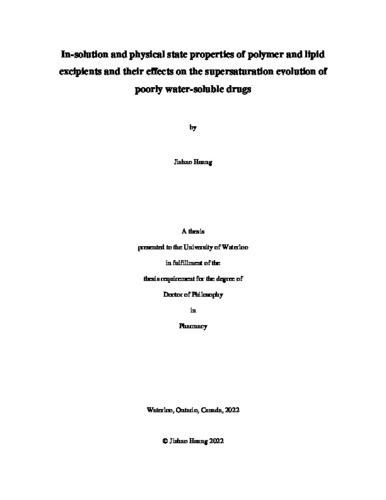| dc.description.abstract | Solubility has become an increasing issue for the pharmaceutical industry, as the advances in combinatorial chemistry and high throughput screening methods have resulted in an increase in the molecular weight and lipophilicity of new chemical entities. There is a constant need for the development of formulation strategies to address these challenges for the oral delivery of poorly soluble drugs. The supersaturated drug delivery system (SDDS) based on amorphous solid dispersion (ASD) is a novel strategy to increase solubility and dissolution of hydrophobic drug compounds in order to achieve an improved oral absorption. The kinetic solubility profile of an ASD formulation in aqueous environment depends on the buildup and maintenance of supersaturated drug solution, which are determined by parameters including drug amorphization state in ASD carrier, drug release from the carrier matrix, liquid-liquid phase separation (LLPS) and nucleation of supersaturated drug solution, and crystal growth rate of drug molecules. These factors are closely correlated to the solid-state and in-solution properties of ASD carrier materials. This thesis aims to investigate the effects of polymer and lipid materials on the LLPS, recrystallization profile, drug-carrier miscibility and dissolution behaviors of two model drugs, indomethacin (IDM) and apixaban (APX), in an effort to benefit both the investigation of fundamental mechanisms of drug supersaturation and the development of pharmaceutical excipients into ASD carriers.
Firstly, the LLPS behaviors of both drugs in the presence of polymer and lipid carriers were successfully characterized using the double wavelength UV extinction method. The LLPS behaviors of both drugs were depended on one or more of the following mechanisms: in-solution hydrogen bonding, drug aggregation facilitated by amphiphilic agents, micelle/vesicle incorporation, and ionization induced solubility enhancement. Polymer or lipid carrier can modify the LLPS behaviours of different drugs in completely different ways depending upon the nature of the drugs. The methodology is expected to serve the LLPS investigations of more types of drugs and excipients. Our work suggests that the effects of excipients on drug LLPS must be analyzed on a case by case basis, given the fact that an ASD carrier can behave markedly differently for different drug compounds.
Secondly, the supersaturation effects of polymer and lipid ASD carriers on IDM and APX under non-sink dissolution conditions were revealed using a solvent-shift method and compared with the identified LLPS properties. Results showed that the supersaturation behaviors of both drugs were influenced by ASD carriers by mechanisms that include in-solution hydrogen bonding, pH-induced solubility change, solubilization, and reduced crystal growth rate. The recrystallization behaviors of both drugs did not necessarily align with the corresponding LLPS results, as LLPS properties were considered to influence the early stage of drug recrystallization. By comparing LLPS and supersaturation result for certain drug-excipient pairs, we also suggested that the different principles of characterization methods may induce variations in the characterization results. Therefore, multiple characterization methods should be combined to obtain accurate in-solution properties of drugs and excipients.
Thirdly, we successfully characterized the drug-excipient miscibility for IDM and APX under a solid state, aiming to analyze the amorphization and loading state of both drugs in different carriers. Meanwhile, the feasibility of using fluorescence techniques to evaluate drug-carrier miscibility was testified by various drug-excipient pairs. Spectral parameters including peak shape, peak intensity and peak wavelength were used to analyze drug-excipient miscibility and physical state of IDM and APX in ASD systems. Distribution of fluorescence intensity and birefringence properties of fluorescence microscopy were also used to analyze the drug-excipient miscibility. Our work suggests that the fluorescence spectroscopy and fluorescence microscopy must be combined to obtain the accurate drug amorphization state in ASD systems, as fluorescence spectroscopy alone may be ineffective in identifying the amorphous drug aggregates in ASD systems. The drug amorphization and loading states were used to analyze the drug release behavior that was closely associated with supersaturation buildup of an ASD formulation.
Lastly, ASDs for IDM and APX were prepared with polymers, lipids, and their combinations as carriers. The dissolution behaviors of prepared samples were tested under non-sink conditions where LLPS and recrystallization were expected to occur. The dissolution and supersaturation parameters were analyzed based on previously investigated properties including LLPS, solubilization, recrystallization, and drug amorphization state. For both IDM and APX, dissolution parameters were greatly influenced by carrier type in different manners. A given type of carrier could provide different effects when it was used to load different drugs. Preparation methods were found to bring inconsistent changes to different formulations. The disintegration, dissolution and dispersion of carrier materials were critical factors to determine the expression of carriers’ ability to generate and maintain supersaturated drug solutions. The correlations between carriers’ effect on crystalline solubility, LLPS, recrystallization, and dissolution parameters could only be established when drug carriers could rapidly and completely dissolve or disperse in dissolution media. The methodology and implications provided by this study could be used to investigate the in-solution and physical-state properties of more types of poorly soluble drugs and potential ASD carriers, in order to benefit the development of ASD formulations. | en |

